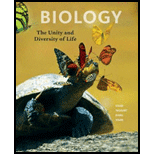
Concept explainers
In cladistics, the only taxon that is always correct as a clade is the _______.
- a. genus
- b. family
- c. species
- d. kingdom
Concept introduction: The taxon “species” is the basic unit of classification, and it is the unit of biodiversity. It comprises of organisms that resemble very close to each other. The term “clade” includes a group of organisms that are believed to comprise all the evolutionary descendants of a common ancestor.
Answer to Problem 1SQ
Correct answer: In cladistics, the only taxon that is always correct as a clade is the species. Therefore, option c. is the correct answer.
Explanation of Solution
Reason for the correct answer: Taxonomy is a biological practice of identifying different organisms, classifying them into different categories, and naming them. Organisms are classified according to their similarities and differences. Each hierarchy of taxonomy is known as taxa and species is the fundamental unit of this taxonomic classification. Cladogram is the pictorial representation of comparison of different groups of animals that are very closely-related with each other because of their shared ancestry. Therefore, both clade and species come under the same category, as the members come under them are much related to each other and also they share a common ancestry.
Option c. is given as “species”. The only taxon that is always the same as a clade is the species. Therefore, option c. is the correct answer.
Reason for the incorrect answers:
Option a. is given as “genus”. It is a taxonomic ranking used in biological classification. It comprises of several species, which are slighty different from each other. Hence, genus cannot be compared with a clade. Therefore, option a. is a wrong answer.
Option b. is given as “family”. In biological classification, it is one of the eight major taxonomic ranks, and it is divided into several subfamilies, which are intermediate ranks above the rank of a genus. As it is composed of several subdivisions, it does not have a group of members with the same characters as a clade. Therefore, option b. is a wrong answer.
Option d. is given as “kingdom”. It is a taxonomic category of the highest rank, grouping together all forms of life having certain fundamental characteristics in common. Hence, it cannot be compared with a clade. Therefore, option d. is a wrong answer.
Hence, options a., b., and d. are wrong answers.
Want to see more full solutions like this?
Chapter 18 Solutions
Biology: The Unity and Diversity of Life (MindTap Course List)
- Can you described the image? Can you explain the question as well their answer and how to get to an answer to an problem like this?arrow_forwardglg 112 mid unit assignment Identifying melting processesarrow_forwardGive only the mode of inheritance consistent with all three pedigrees and only two reasons that support this, nothing more, (it shouldn't take too long)arrow_forward
- Oarrow_forwardDescribe the principle of homeostasis.arrow_forwardExplain how the hormones of the glands listed below travel around the body to target organs and tissues : Pituitary gland Hypothalamus Thyroid Parathyroid Adrenal Pineal Pancreas(islets of langerhans) Gonads (testes and ovaries) Placentaarrow_forward
- What are the functions of the hormones produced in the glands listed below: Pituitary gland Hypothalamus Thyroid Parathyroid Adrenal Pineal Pancreas(islets of langerhans) Gonads (testes and ovaries) Placentaarrow_forwardDescribe the hormones produced in the glands listed below: Pituitary gland Hypothalamus Thyroid Parathyroid Adrenal Pineal Pancreas(islets of langerhans) Gonads (testes and ovaries) Placentaarrow_forwardPlease help me calculate drug dosage from the following information: Patient weight: 35 pounds, so 15.9 kilograms (got this by dividing 35 pounds by 2.2 kilograms) Drug dose: 0.05mg/kg Drug concentration: 2mg/mLarrow_forward
- A 25-year-old woman presents to the emergency department with a 2-day history of fever, chills, severe headache, and confusion. She recently returned from a trip to sub-Saharan Africa, where she did not take malaria prophylaxis. On examination, she is febrile (39.8°C/103.6°F) and hypotensive. Laboratory studies reveal hemoglobin of 8.0 g/dL, platelet count of 50,000/μL, and evidence of hemoglobinuria. A peripheral blood smear shows ring forms and banana-shaped gametocytes. Which of the following Plasmodium species is most likely responsible for her severe symptoms? A. Plasmodium vivax B. Plasmodium ovale C. Plasmodium malariae D. Plasmodium falciparumarrow_forwardStandard Concentration (caffeine) mg/L Absorbance Reading 10 0.322 20 0.697 40 1.535 60 2.520 80 3.100arrow_forwardPlease draw in the missing answer, thank youarrow_forward
 Concepts of BiologyBiologyISBN:9781938168116Author:Samantha Fowler, Rebecca Roush, James WisePublisher:OpenStax College
Concepts of BiologyBiologyISBN:9781938168116Author:Samantha Fowler, Rebecca Roush, James WisePublisher:OpenStax College Essentials Health Info Management Principles/Prac...Health & NutritionISBN:9780357191651Author:BowiePublisher:Cengage
Essentials Health Info Management Principles/Prac...Health & NutritionISBN:9780357191651Author:BowiePublisher:Cengage Human Biology (MindTap Course List)BiologyISBN:9781305112100Author:Cecie Starr, Beverly McMillanPublisher:Cengage Learning
Human Biology (MindTap Course List)BiologyISBN:9781305112100Author:Cecie Starr, Beverly McMillanPublisher:Cengage Learning Biology: The Dynamic Science (MindTap Course List)BiologyISBN:9781305389892Author:Peter J. Russell, Paul E. Hertz, Beverly McMillanPublisher:Cengage Learning
Biology: The Dynamic Science (MindTap Course List)BiologyISBN:9781305389892Author:Peter J. Russell, Paul E. Hertz, Beverly McMillanPublisher:Cengage Learning Biology (MindTap Course List)BiologyISBN:9781337392938Author:Eldra Solomon, Charles Martin, Diana W. Martin, Linda R. BergPublisher:Cengage Learning
Biology (MindTap Course List)BiologyISBN:9781337392938Author:Eldra Solomon, Charles Martin, Diana W. Martin, Linda R. BergPublisher:Cengage Learning





